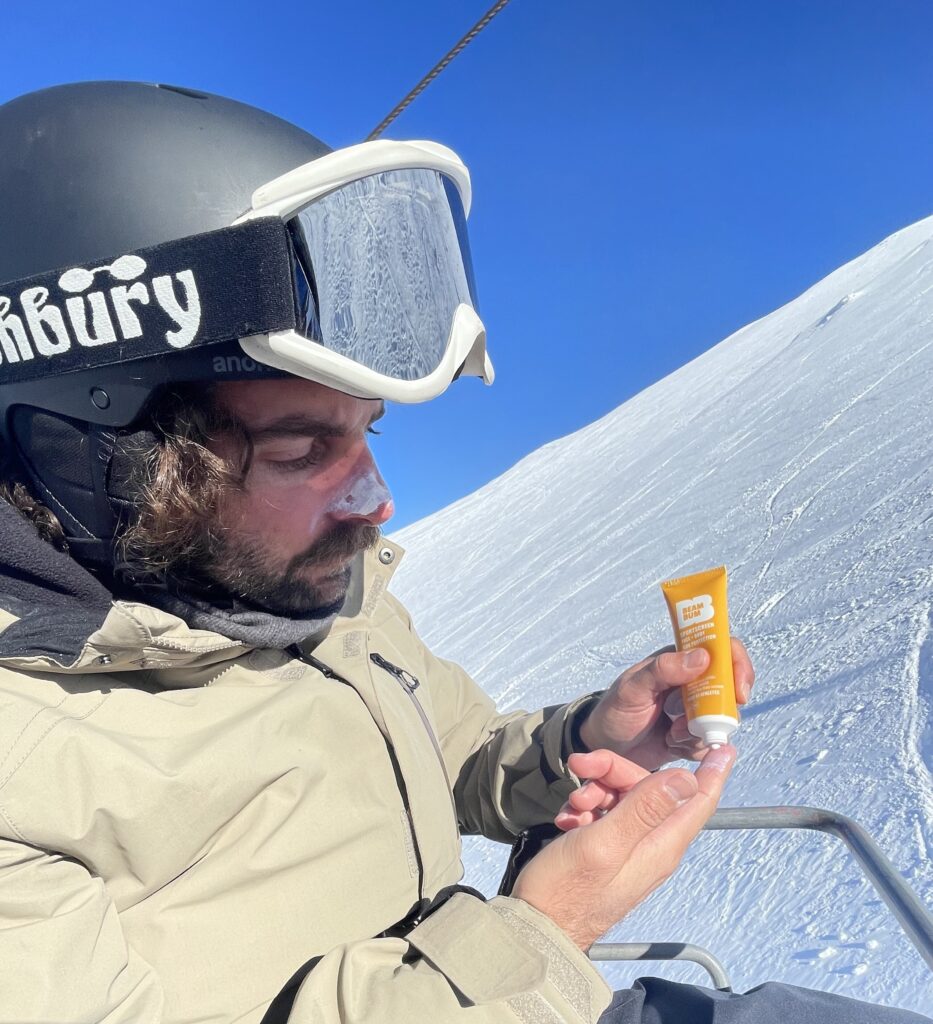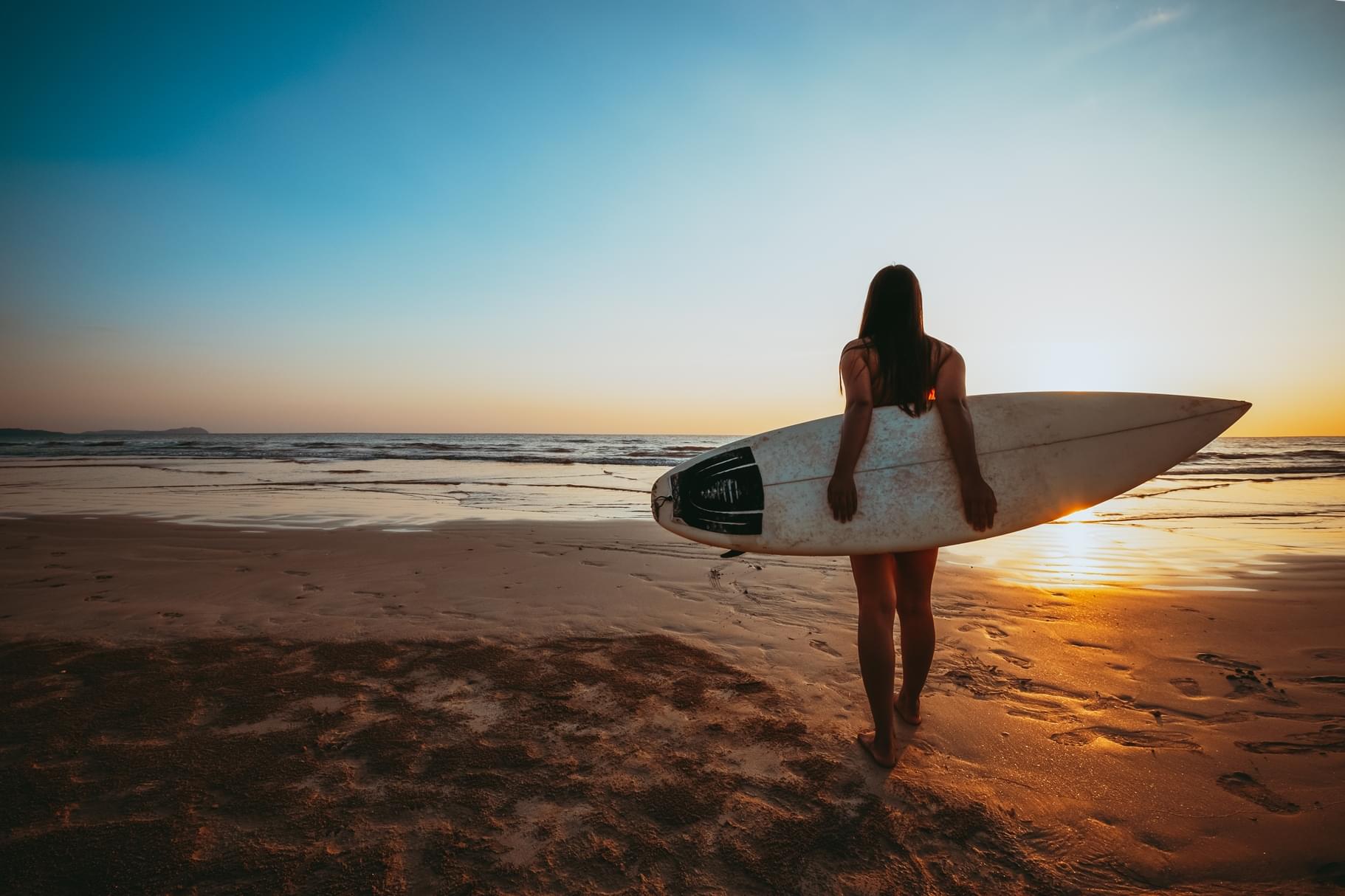7 Mistakes Skiers/Snowboarders Make When Applying Sunscreen
If you’re anything like me, then you’re probably guilty of a few of these mistakes. Let’s see what you score…
#1 Only apply sunscreen to exposed skin
Applying sunscreen to exposed skin is a no-brainer. But, for skiers / snowboarders with all the clothing and gear involved, it’s easy to miss some spots. As a result, the most common mistake is to apply sunscreen only on the face and neck.
If you’re wearing a helmet or goggles, make sure to put sunscreen on your forehead, under your chin and on the tops of your ears. Put lotion on your nose, cheeks and neck (areas that are often exposed). And if you wear a balaclava under your helmet or goggles, don’t forget to put sunscreen on it.
Covering up doesn’t mean you don’t need sunscreen. Even if you’re wearing a ski mask, scarf or hooded jacket, the skin that’s exposed will still get UV damage, as UV rays can penetrate through fabric.
#2 Skip SPF lip balm
It’s easy to forget applying SPF on the lips but here is why you shouldn’t! The first is that the skin on your lips is thinner than anywhere else on your body, so it’s easier to burn. The second is that the sun reflects off snow and ice, increasing your exposure. Lips also get windburned, which can exacerbate a burn. Sunburns can not only cause pain and cracking, but they can also lead to skin cancer.
The best way to protect your lips from the sun is with an SPF lip balm (and reapplying it throughout the day), but if you’re one who often loses lip balm through one means or another, you should consider wearing a neck gaiter (aka a face mask) instead.
#3 Reach for the same sunscreen they use in a summer day at the beach
Well, one may think that SPF is just SPF. But it isn’t! Unless you are using a specialized sports sunscreen anyway in the summer, the ingredients in beach commercial sunscreens are designed to protect against UVA and UVB rays, but they don’t adhere well to the skin in cold weather.
For sports like skiing and snowboarding, where you’re working up a sweat, even on a chilly day, look for a formula that contains zinc oxide and titanium dioxide. These mineral-based sunscreens block both UVA and UVB rays, making them great for winter activities. They also won’t break down as quickly when you start to sweat.
#4 Wait until they're already at the lift before applying sunscreen
The problem with sunscreen is that it’s a pain to apply. It takes a while and you have to be careful to cover every inch of exposed skin, which is unpleasant. So, in theory it makes sense to be efficient and apply sunscreen at the lift, right?
WRONG! In practice this is just not working for 2 reasons. First, you’ll be rushing, which means you might miss spots or wipe it in your eyes. Second, this is when the sun’s rays are strongest — right during that time of day when you’re most likely to burn.
The best time to apply sunscreen is in the car. It’s warm, allowing you to take your time, and it’s dark enough that you don’t have to worry about the sun. Just make sure to apply another layer once you get off the lift at the end of the day.

#5 Only apply sunscreen when the sun is out, not when it's cloudy or overcast
″It’s cloudy, so I don’t have to wear sunscreen!” is what most of us subconsciously think. Not only when we go hitting the slopes, but on any cloudy day. However, this is a trap. Although you may not feel the sun burning you on a cloudy day, you still need to wear sunscreen. According to the American Academy of Dermatologists, 80% of the sun’s rays still make it to the ground on a cloudy day [1]. Not to mention that for those hitting the slopes, wearing sunscreen on a cloudy day is even more important, as the UV rays reflect off the snow amplifying their effect. And let us not neglect incidental exposure. The sun can come out at any moment during a cloudy day and, even if it stays for 5 minutes, incidental exposure adds up quickly and gets your skin to age prematurely. So, why risk it?
#6 Don't know how to properly apply sunscreen
You put on sunscreen, but, let’s face it: you are not putting on enough! Do it right and put on more than you think you need: Use twice as much sunscreen as you think you’ll need and apply liberally. The rule of thumb is to use a shot glass worth of sunscreen for your face, arms, neck and chest area (front and back). If you’re wearing clothes that cover your arms, use a tablespoon worth for each arm, if your legs are covered then use a tablespoon for each leg.
If you are pale and burn easily, do not settle with a product less than SPF 50+.
Equally important is re-applying frequently. Even if a sunscreen claims to be water- and sweat-resistant that doesn’t mean that applying it in the morning will cover you until you get home in the evening. A sunscreen containing zinc oxide and titanium dioxide won’t break down as quickly when you start to sweat, but still…it would be wise to re-apply a couple of times before you are done for the day!
#7 Assume water-resistant and sweat-resistant sunscreen stays on longer than it actually does
While sunscreens claiming to be water-resistant and sweat-resistant are formulated to stay on longer if you are swimming or sweating. It doesn’t mean that they offer enough covering for the whole day of your outdoor extreme activities. These sunscreens are designed not to wash off but to be absorbed into your skin. They still do break down due to the extended exposure to UV rays so they stop working after a certain point. So do it right! Re-apply every 2-3 hours whether your sunscreen is water- and sweat-resistant or not.
Related posts
New to Snowboarding? 5 Tips for beginners…
Are you new to snowboarding? Have you taken a few lessons or tried it anyway a couple of times and l






Leave a comment